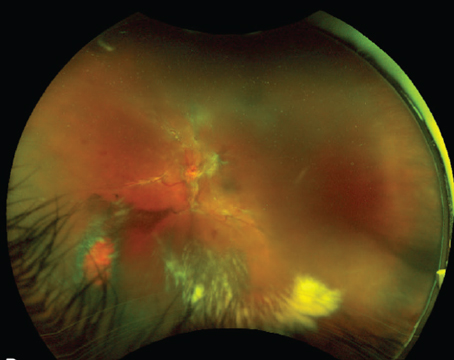The iPhone 11 series was released on September 20, touting longer battery life, faster processing speeds and a dual- and triple-camera set up. Apple assures customers, “It just got a whole lot harder to take a bad photo.”1
The low-end 11 model is available in six different colors: black; green; yellow; purple; red and white. The premium models—the Pro and Pro Max—come in gold, space gray, silver, and midnight green.
In this article, experts weigh in on the features of the new iPhone 11 and how they stack up against previous models.
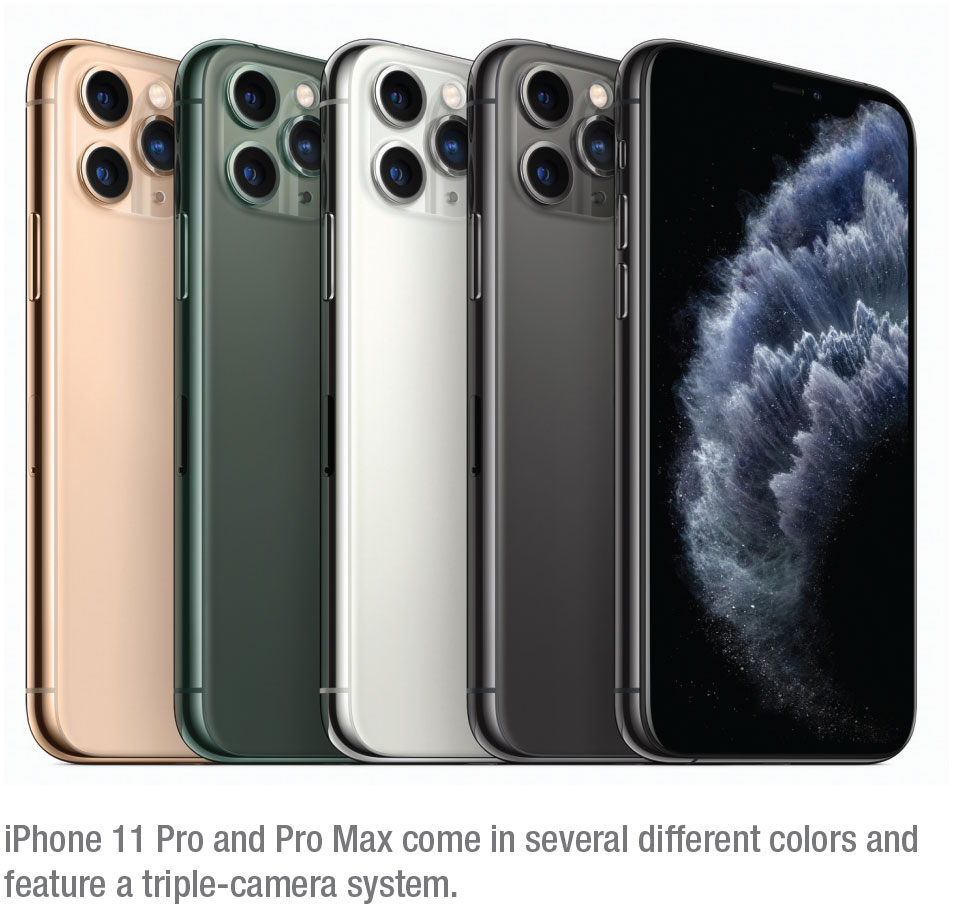 |
At First Sight
Doctors will appreciate the iPhone 11’s robust battery life and enhanced durability, says Ken Lord, MD, of Retina Associates of Southern Utah. “This phone also has a more powerful processor, which means certain things are going to work a little faster, like the face recognition software on the lock screen. When we’re desperate for time, even tiny increments in speed help us,” he says.
The iPhone 11 runs on Apple’s new A13 bionic chip, which is a six-core processor that includes two performance cores (2.65 GHz each) and four energy-efficient cores. Apple hasn’t disclosed the battery power of the iPhone 11, but claims the iPhone 11 will last one hour longer than the iPhone XR. The iPhone 11 Pro is said to last four hours longer than the iPhone XS and the Pro Max five hours longer than the XS Max.
“The other major upgrade with the iPhone 11 is the camera,” says Rohit Krishna, MD, director of the glaucoma service and professor of ophthalmology at University of Missouri Kansas City School of Medicine. The iPhone 11 has two 12-megapixel ultra-wide and wide cameras in the rear, and one in the front. The Pro model features three rear cameras and includes a telephoto lens. Dr. Krishna says, “The new low-light technology actually gets a pretty good picture with high resolution. Cinematography is also better—this phone shoots in 4K.”
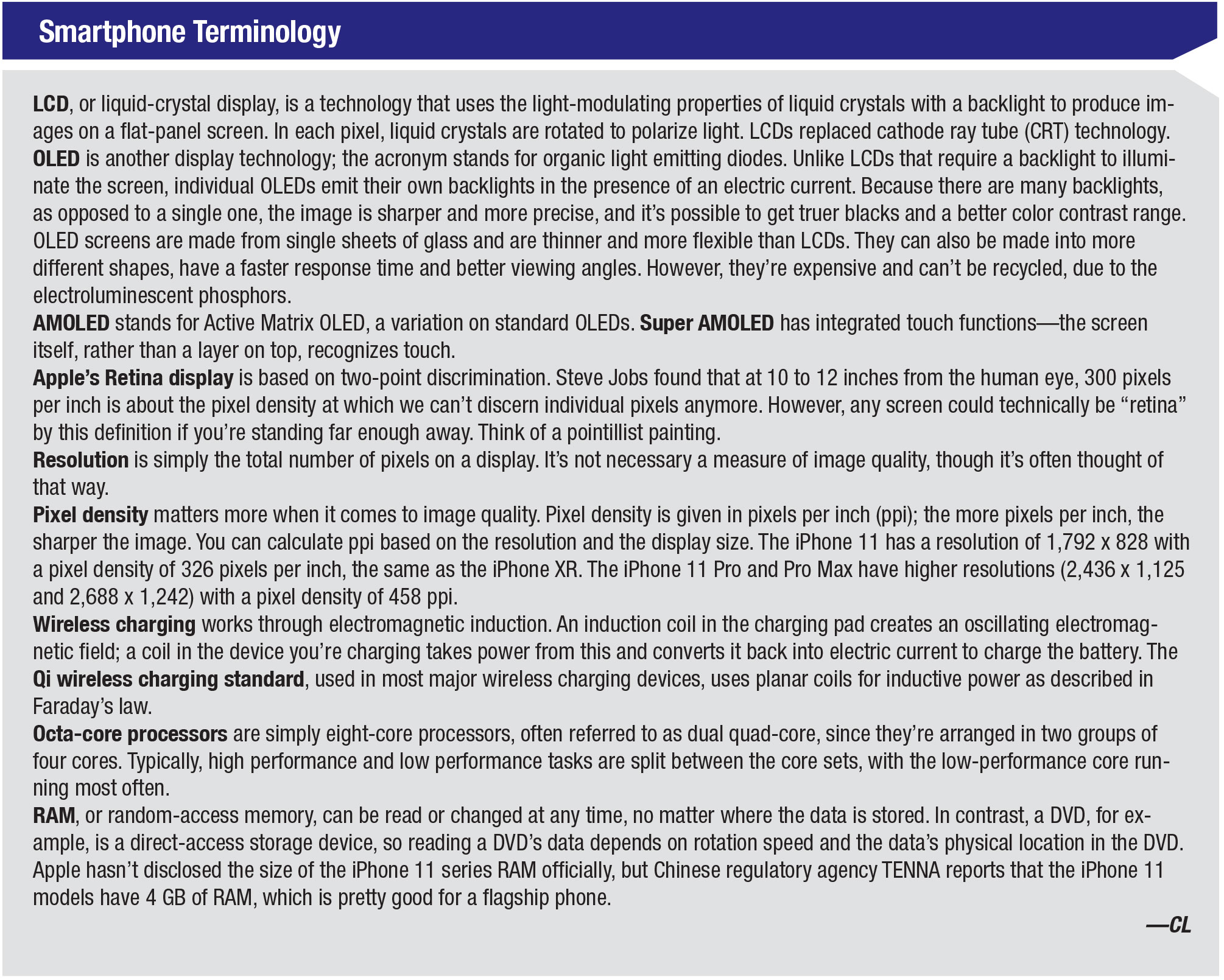 |
A Discerning Eye
The iPhone 11 sports the same screen specs as the XR, a 6.1-inch all-screen display with Apple’s liquid retina HD screen (a type of LCD screen). The Pro and Pro Max versions of the iPhone 11 have 5.8-inch and 6.5-inch screens, respectively, with OLED (organic light emitting diode) displays. OLED has certain advantages over LCD in terms of design and function that will probably make it the technology of choice in future screen-based technologies. (For more detailed explanations of certain terms used in this article, see the “Smartphone Terminology” sidebar, above) Dr. Lord says OLED displays provide the highest quality images yet, with better color contrast and truer blacks.
But when it comes to pixel density and resolution, Dr. Lord says the upgrades in resolution we’re seeing (or not seeing, rather) don’t make a huge difference. “The resolution on a retina screen is actually better than what the human eye can discern,” says Dr. Lord. That’s due to two-point discrimination. He explains, “Ten years ago, you could see the individual pixels on CRT or LCD screens. Now resolutions are so high that we can’t discern individual pixels. It looks great, but you can add as much resolution as you want, and we’re not going to be able to tell.”
The iPhone 11 has a resolution of 1,792 x 828 with a pixel density of 326 pixels per inch, the same as the iPhone XR. The iPhone 11 Pro and Pro Max have higher resolutions, each with a pixel density of 458 ppi. The major display upgrade between the 11 and the Pro or Pro Max would be screen type—OLED over LCD—more than pixel density.
Stereoscopic Vision
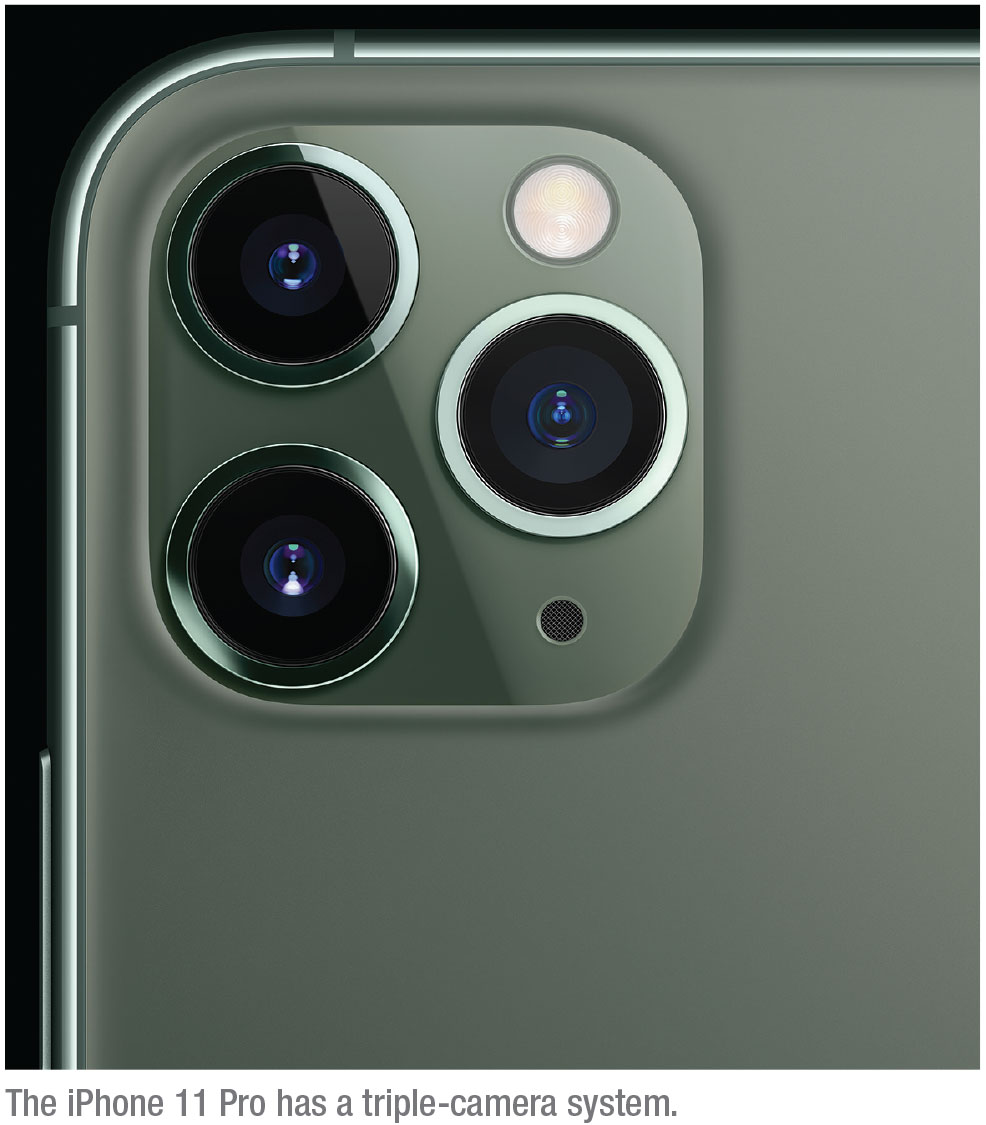 |
The iPhone 11’s dual-camera technology mimics the human eye in more ways than one. The ultra-wide and widefield lenses aid in depth perception and focusing. Additionally, like rod and cone cells, one lens captures monochrome data while the other captures RGB data. The company says that combining the contrast and color data from both lenses yields a more vivid, detailed image—especially in low light, because the dual input allows for greater light capture without extended exposure time.
The iPhone 11 Pro and Pro Max have a triple-camera system: the 120-degree field-of-view ultra-widefield lens; the wide lens; and an additional 52-mm focal length telephoto lens with 2x optical zoom. The telephoto lens combined with the other two allows for an expanded field of view with a 4x optical zoom range. Machine learning and algorithms improve highlights and details, as well as recognize faces to relight them.
Connectivity
The iPhone 11 comes with a USB Type-A cable, so if your MacBook is from 2015 or later, you’ll need an adapter in order to work with the laptop’s USB Type-C port. The iPhone 11 Pro and Pro Max have USB Type-C connectors. USB Type-C is becoming the new connection standard for data transfer and device charging; it’s much smaller than USB Types-A and -B and can therefore be used on slimmer, lighter devices. You also won’t have to flip a USB Type-C connector over at least three times to fit it into the port.
Wireless charging and fast-charge capabilities are both possible for the iPhone 11 with a wireless charging pad or an 18-W adapter, sold separately. However, “there’s no reverse charging,” says Vinay Shah, MD, of Dean McGee Eye Institute at the University of Oklahoma in Oklahoma City. “I was hoping for that.” Reverse charging allows you to use your phone to charge another phone with reverse charging capabilities. It’s a slow, low-power process meant more for sustaining a battery that’s at the dreaded 5-percent level.
Storage Capacity
The iPhone 11 starts at $699 for 64 GB of storage. You can upgrade to 128 GB ($749) or 256 GB ($849). The iPhone 11 Pro has greater storage capacity—up to 512 GB for $1,449. As with previous models of the iPhone, there are no expandable memory capabilities.
For Dr. Krishna, the limited 64 GB capacity of the lower-end iPhone 11 isn’t a big deal. “I ultimately see storage capacity going away since everything is moving to the cloud,” he says. “I’ve moved over to the cloud this year. I don’t even use my local hard drive anymore on my Mac.” However, users who haven’t moved to the cloud or prefer local storage may find the 64-GB capacity restrictive, especially for storing high-quality photos and 4K videos.
For comparison, the latest Samsung phone released in September (though not yet available in the United States), is the Galaxy A90 5G. This 5G smartphone features a 48-megapixel rear camera, a 32-megapixel front camera and a Super AMOLED 6.7-inch display. It has 6 or 8 GB of RAM and an octa-core chip with processing speeds of 2.84 GHz, 2.42 GHz and 1.8 GHz. The phone comes with 128 GB of internal storage and can also
accommodate a microSD card up to 512 GB for a total of 640 GB of storage capacity. It’s one of the cheaper 5G phones available, starting around $827.
Artificial Intelligence
Dr. Shah says the iPhone 11 Pro is better-suited for artificial intelligence and machine learning than previous models because of its processing power. “This may be the leap they’re looking for in this phone,” he says. Apple’s A13 bionic chip in the iPhone 11 Pro has an octa-core processor with a machine-learning focus, according to Apple. Machine learning and artificial intelligence play a major role in digital camera technology like image stabilization and facial recognition, but they have many more potential applications.
“The big thing we talk about in ophthalmology with machine learning is diagnosis and fundus imaging,” says Dr. Shah. “The only FDA-approved artificial intelligence system for ophthalmology is the IDx-DR system, which uses AI to diagnose diabetic retinopathy. In theory, a patient could use a phone to take fundus pictures, apply pattern recognition and AI, compare it to other pictures in a depository and then use the phone’s processor to self-diagnose diabetic retinopathy and other ophthalmologic disorders; this would be especially useful in rural settings or developing countries where retina specialists or general ophthalmologists aren’t readily available.”
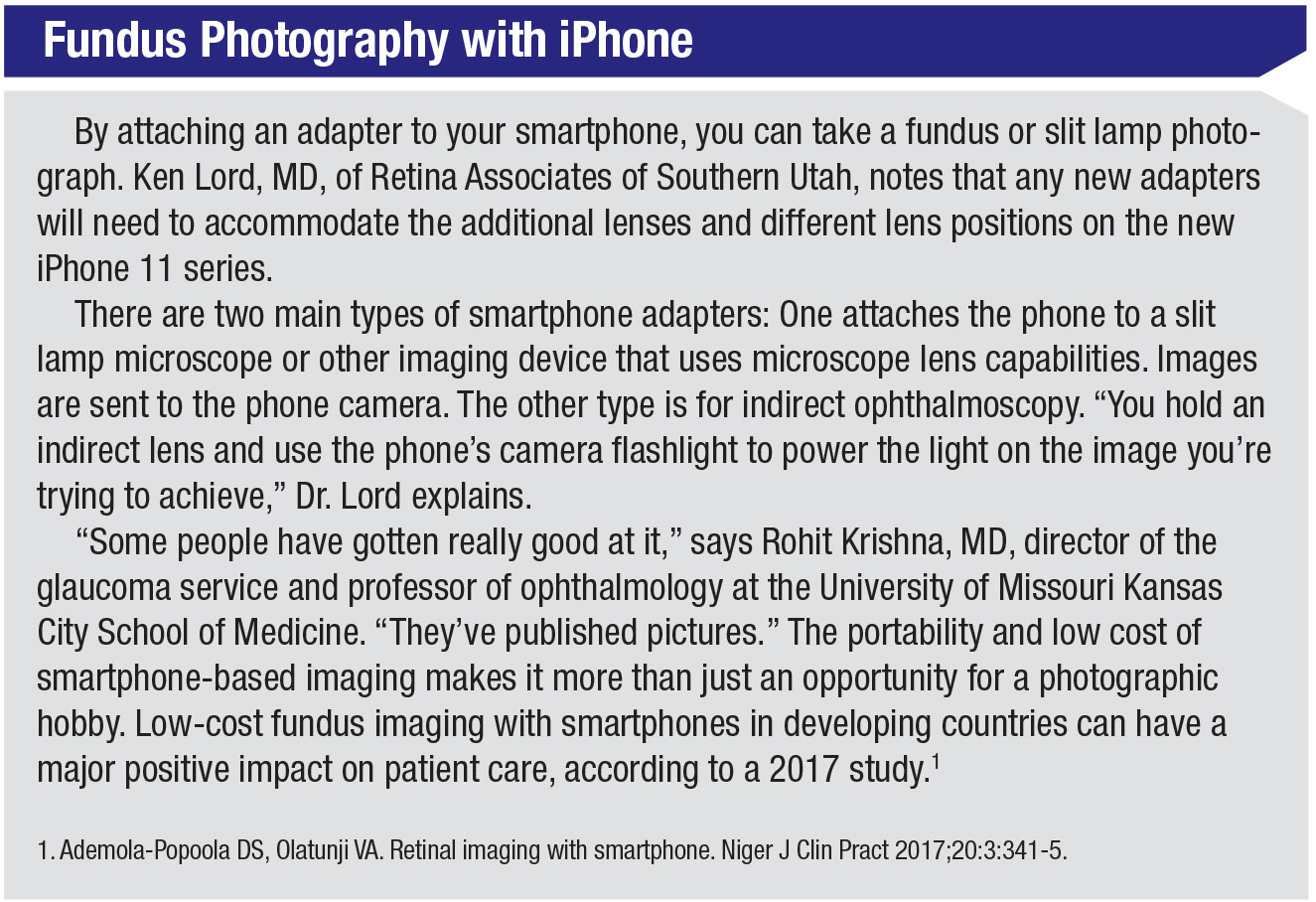 |
No 5G for iPhone
The 5G wireless transmission standard is coming—and it’s coming fast. 5G networks are exponentially faster than previous transmission standards like 4G and 3G networks. This means faster upload and download speeds and greater signal strength.
Dr. Krishna says next year’s iPhone will supposedly have a 5G chip. “There’s going to be a lot of cool things with 5G,” Dr. Krishna says. “It all has to do with speed. It wouldn’t surprise me to see products using more artificial intelligence or augmented reality—maybe even holograms.
“For ophthalmologists, getting 5G will be a huge upgrade,” he continues. “I think you’ll see it permeate ophthalmology a bit more. For the most part, we haven’t been too involved with augmented reality and virtual reality, but I can see more integration with those activities if we had 5G speeds.” Augmented reality can be used for planning surgeries, and a surgeon wearing a headset can see digital information directly projected over the visual during procedures.
A Clinical Multi-Tool
Speed and long-lasting battery life aren’t just useful for streaming movies. Though many of the fun features of iPhone 11 will be more applicable to your personal life than to work, a good phone is now an important tool to have. Here’s a look at some of the ways smartphones have reshaped the clinic:
• As your on-call bag. “You have EHRs, a blue light, a flashlight, color plates and fixation targets all on your phone now,” says Dr. Shah. “We used to have a toy or something to distract a child, but now it’s your phone—every kid loves a phone. If you have an interesting fixation target on your phone, that’s a very powerful tool to grab the child’s attention so you can examine them.”
• As a pager. Dr. Shah says that 10 years ago, he used to carry around a pager, a personal digital assistant and a flashlight. “All of that is now my iPhone,” he says.
• As a reference. You can download the Wills Eye Manual to your phone for convenient reference in the clinic or on call. Dr. Shah says Google is another resource that may offer a rare diagnosis you hadn’t thought of—though perhaps don’t tell your patients you’re Googling their conditions.
• For a second opinion. “If you want to get a second opinion on the fly as you’re in the clinic, you can take a picture of some test results and send it to your friend,” says Dr. Shah. “But be mindful of HIPAA—text messages aren’t HIPAA-compliant, but as long as no patient information is visible, it should be okay to send a generic picture for getting a second opinion. You should use a secured email service instead of text messaging for sending sensitive information.
“Another great resource is forums,” continues Dr. Shah. “The cornea people have their forums and the glaucoma people have theirs. You can post pictures on subspecialty forums and get multiple opinions from all over the world—that’s a great asset.”
• For office work. Dr. Shah says your phone is your scanner, your Rolodex, your file storage and your meeting place—with video-conferencing apps, you can hold meetings anywhere.
Working From Phone
You can access your EHR remotely from your phone and even view your patient images, since most major imaging devices now have mobile portals. Dr. Shah adds that with the correct apps, you can also do coding.
Being able to look up patient medical records from your phone while on call is convenient, but Dr. Krishna says to make sure you’re using an app like Citrix, which handles workplace encryption and secure access.
“Right now, our phones are just a window to a desktop system,” says Dr. Lord. “If I want to log into my EHR to look up my patient, it’s not on some dedicated app that’s intuitive and user-friendly. Some EHRs have been specifically designed for iPads, but mine was not.”
Patient portals are also shifting to mobile devices, since more and more people are doing things on their phones, notes Dr. Lord. He says that “companies are trying to improve mobile patient portal interfaces, but there’s still a long way to go.” Having an easy-to-use patient portal for mobile devices makes it more likely that patients will use the portals.
Should You Get the New iPhone?
Ultimately, tech specs won’t be the only factors that influence your choice of smartphone—Apple’s latest and greatest is appealing for more reasons than its 2.65-GHz processors or its 2,000,000:1 contrast ratio. Many will purchase the iPhone 11 out of brand loyalty or a desire to have the newest Apple product. Others will choose it just because it looks like a really cool phone.
One caveat: Dr. Lord notes that a cool phone won’t make you a better doctor, though a faster one might help you be more efficient at work.
Dr. Krishna says that if you’re a photography buff or if you find your battery is always running out and don’t carry a spare, upgrading to the iPhone 11 could be a good move. The greater processing power of the premium models is also a draw, he says.
From the XR to the 11, there’s not a huge leap besides the improved camera technology. The Pro and Pro Max with their triple-camera systems, OLED display technology and octa-core processors are a step up from previous iPhone models and carry the aesthetic appeal of the Apple brand, but many other phones on the market also have OLED displays, multiple camera lenses and octa-core chips. However, sometimes minor upgrades in phones are good. Dr. Shah points out that too many differences in a phone upgrade can be difficult to adjust to.
The room for improvement may be diminishing as well. “The iPhone 11 is a better phone than the iPhone 10,” says Dr. Lord. “But is the ‘better’ offering us more functionality over previous models?” He says we’ve plateaued. Moore’s Law forecasted exponential growth in computing power—and for a long time, technological innovations followed along this steep growth trajectory: We had floppy disks and 5-MB hard drives not so long ago, and today we have phones that can match a standard laptop for computing power. Now the growth seems to be slowing.
“It’s like driving a car,” continues Dr. Lord. “The technology behind cars has been the same for 80 years: four wheels, a steering wheel, and you drive down the road. Now they’re faster and you have cruise control, but the concept’s the same. Cars are also getting better and better, but a car today accomplishes the same thing as it did 20 or 40 years ago.”
This is the case for almost all smartphones on the market. And like cars, the race for innovation among smartphone manufacturers seems centered on adding more of everything—more megapixels, more camera lenses, the latest display technology. But as these experts point out, “more” doesn’t always mean discernibly better. REVIEW
Drs. Lord, Krishna and Shah are the developers of and have financial interests in ophthalmic reference apps called EyeHandbook and EyePatient.
1. iPhone 11. Accessed Oct 3 2019. apple.com/iphone-11.
